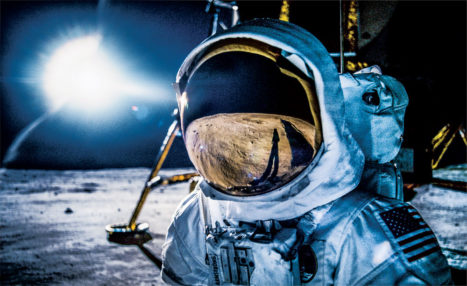 Rather than the normal column of one new release and one streaming film/show, this month I give you two reviews of recent, wonderful, historical documentaries. Enjoy the nice, light summer viewing!
Rather than the normal column of one new release and one streaming film/show, this month I give you two reviews of recent, wonderful, historical documentaries. Enjoy the nice, light summer viewing!

Apollo 11
Apollo 11 (2019)
This new documentary from writer, producer, director, and editor Todd Douglas Miller is a truly miraculous visual feat. The footage is taken from previously unseen 70mm images, archival video, and still photos of the famous mission. We get to see rare images of the launchpad, the astronauts, the crowds, the liftoff, the entry into space, the astronauts on the voyage, the moon up-close, breathtaking footage of the actual moon landing, and then their return to Earth. Miller sorted through hundreds of hours of footage and countless hours of audio tapes to create an artistic piece that is worthy of its scientific subject.
Just think—we sent men to the moon with less technology than we have in our cell phones. The film itself is the beneficiary of such scientific ingenuity. NASA, along with the National Archives and Records Administration, transported the delicate film cans in specially-designed refrigerated vans from Washington DC to New York City. Miller then used digital restoration programs to clean the footage, assemble it, and finally, to put it all together. A Canadian engineer developed new software to clean the audio tapes and synch it with the visuals. The resulting film, which premiered at Sundance this past January, is stunning.
While the cinematography itself is truly beautiful, the editing is the center of the film. There is no voiceover narration in the film, nor are there any new interviews included. The film stays in the contemporaneous moments of 1969. In one truly remarkable sequence, as Armstrong pilots the landing module onto the moon, the screen splits to show the reactions of the control room in Houston. While the lander is finding an appropriate spot to land, it becomes increasingly clear that they are running out of fuel. The screen splits again to show you the fuel counter. We now feel what everyone felt—are they going to land before running out of fuel? It is the film’s great accomplishment that it creates such tension and unease when we already know the outcome! My 10-year-old son covered his eyes.
The 50th anniversary of the moon landing in 1969 is certainly worthy of celebration. It was a scientific achievement and a human endeavor that simultaneously made us feel as though we could accomplish anything while understanding our smallness in the universe. It stands as one of the great human achievements, and watching it unfold before your eyes is like being a kid all over again. It makes you feel like we can really do anything. Watch it with your kids, as I did with mine.
Now playing on all VOD outlets.

They Shall Not Grow Old
They Shall Not Grow Old (2018)
Peter Jackson’s powerful documentary about British soldiers in WWI is a relentless visceral experience that literally places us in the boots of the soldiers fighting on the Western front. We feel for them, we identify with them, we sympathize with them, and we root for them. We are sutured into the trenches with them and experience what they experienced. The entire film uses restored and colorized World War I footage overlaid with original audio of soldiers from the war. Jackson waded through hundreds of hours of film footage and countless more hours of audio tapes recorded in the 1960s and 70s by the BBC. His own grandfather fought for the British during the war, and he grew up hearing war stories. When the BBC and the British Imperial War Museums approached him about making a documentary commemorating the 100-year anniversary of the War, he jumped at the chance.
Jackson was faced with a myriad of challenges and a plethora of choices. The initial challenge was to take the World War I footage, clean it, and digitize it. Jackson then decided to “modernize” the footage—first, he had to take the jerky, Charlie Chaplin-esque footage, and format it for today’s projection techniques. The cameras at the time were hand-held, hand-cranked, first-generation cameras. The medium of film had been invented only 25 years earlier, with a standard projection rate of 18 frames per second. In the sound era, the industry moved to 24 frames per second, to synch sound and to mimic realistic movement. After overcoming that hurdle, Jackson then decided to colorize the footage. He stated that the soldiers of the era saw the world in color, and he wanted us to see what they saw. Full disclosure: this critic despises colorizing old footage. But it works here. Jackson’s audacious choices give us a sensory experience unlike any other I have seen in a war picture.
This is not a film about the larger war, the battles, the planning, or the generals. This is a film about the soldiers living in the trenches and relaxing on their days off. The jocularity of certain images is reinforced by the striking narration of the actual soldiers. Who knows if the soldiers, speaking some 50 to 60 years after the war, remember everything accurately. But it was their war and their experiences. The film is jarring, tense, and sometimes disturbing. Watching the soldiers walk along the trenches with dead bodies surrounding them is horrifying. The audio of the soldiers nonchalantly describing one-on-one battles with German soldiers is shocking and strangely alluring. We realize that they were just boys, on both sides. In the end, this is a film about humanity. And a lot of it.
Now playing on all VOD outlets.
Vincent Piturro, Ph.D., is a Professor of Film and Media Studies at Metropolitan State University of Denver. He can be reached at vpiturro@msudenver.edu. Or follow him on Facebook and Twitter.




0 Comments